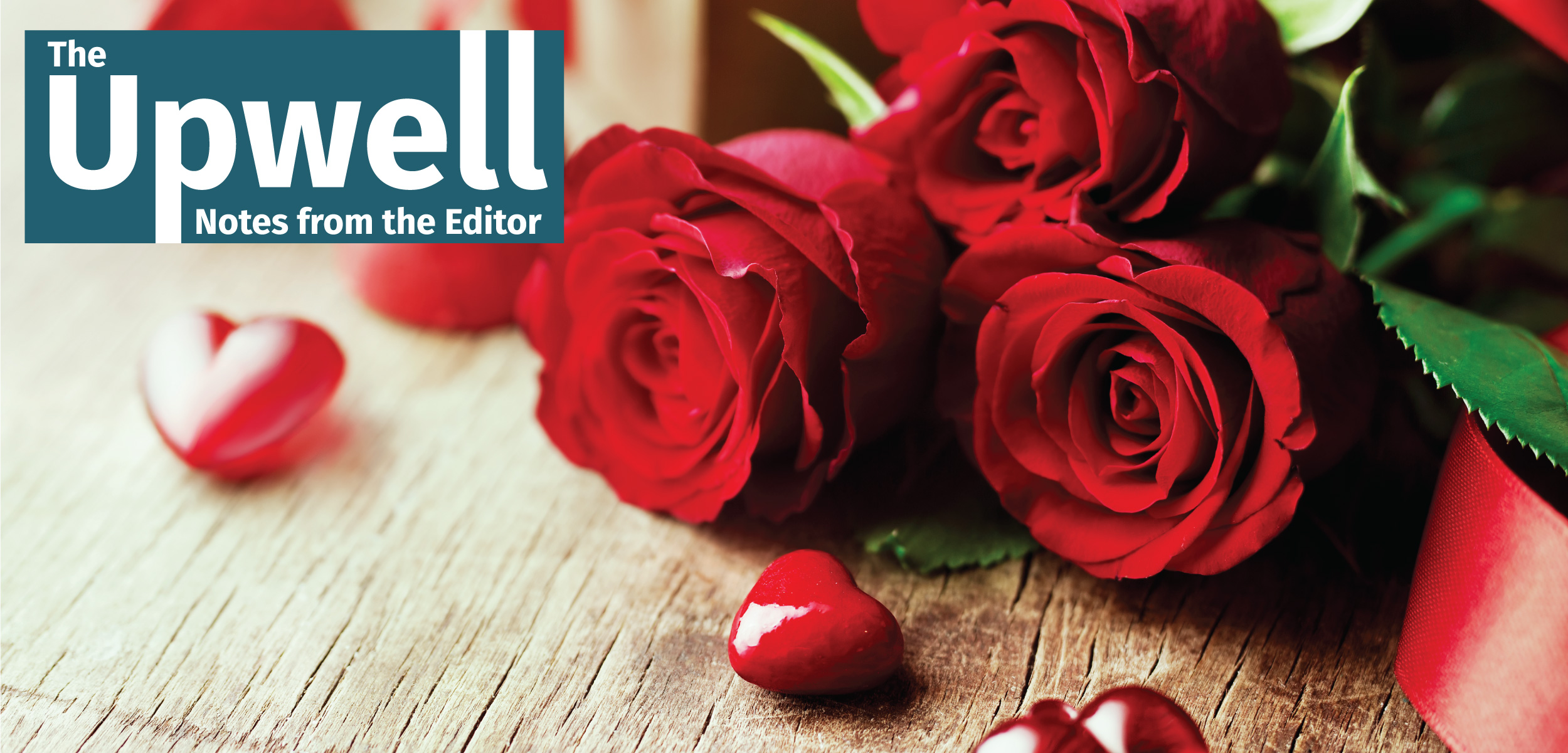Are You Giving Flowers with a Side of Plastic?
A flower arrangement delivers all sorts of messages, but it can also deliver plastic waste to our environment, especially when it includes floral foam.
Article body copy
The Upwell: Notes from the Editor is a semiregular column that brings you analysis of emerging issues impacting coastlines around the world.
Over a century ago, flower retailer Florists’ Telegraph Delivery group—more recognized as FTD—started the campaign “Say it with flowers” for Mother’s Day. And we’ve been saying it—I love you, I miss you, I’m thinking of you, I’m sorry, or congratulations on your new baby/home/job—ever since. Flower person or not, chances are you’ve recently intersected with a bouquet or arrangement—at a bank or hotel, at a wedding or graduation, on a table at a café. Look closely, and you’ll see the power of flowers; their ubiquity in our day-to-day.
And, honestly, what’s not to love? Flowers are beautiful, they’re natural, they lift our spirits and fill interior spaces with color and scent. They let us say things without having to say too much, and they even have their own language—a yellow chrysanthemum for slighted love, a purple hyacinth for sorrow, a scarlet geranium for stupidity according to the Victorian-era The Language of Flowers. But it turns out—at least when it comes to the way we’re currently growing, buying, and designing with flowers—the secret language of flowers might be hypocrisy. There’s a virtuous halo around flowers that causes us to gloss over the very real costs of getting them out of the soil and into the vase.
Consider the red rose, more than 250 million of which will soon be landing in the arms of Americans for Valentine’s Day. Depending on where they’re grown and purchased, those long-stemmed roses—flower code: love—could also come with the carbon footprint of a heated greenhouse and refrigerated air and road miles, and residues of pesticides and fertilizers, all bound in a non-recyclable plastic sheath.
As with the ethical questions around food and fashion, there’s a growing reckoning around the true environmental and social costs of flowers. Inspired by the slow food movement—with its vision for a world in which all people can access food that is good for them, for the growers, and for the planet—Seattle, Washington–based garden writer Debra Prinzing released the book Slow Flowers in 2013, making the case for seasonal and local flora. Through her magazine writing, she’d been meeting flower farmers and the florists who were designing with locally sourced botanicals.
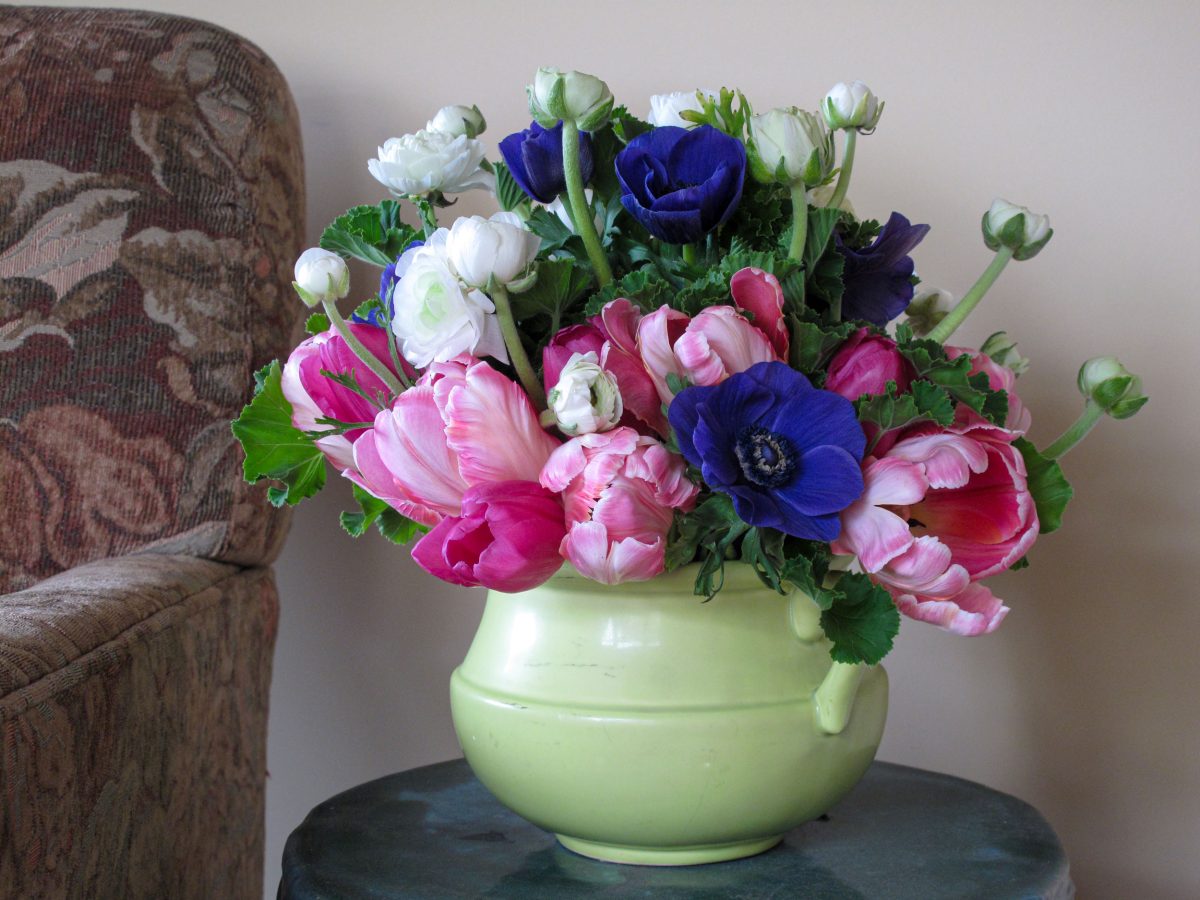
The burgeoning slow flowers movement encourages locally grown, seasonal flowers, designed without plastics or other harmful floristry practices. This spring bouquet—an alternative to imported red roses—uses flowers available locally in Washington State. Photo courtesy of Debra Prinzing
“They were like the chefs in the slow food world,” Prinzing says. “They were the creatives in the slow flower world.” Today, she’s a slow flowers evangelist with an online database that connects florists, wedding and event planners, and other flower consumers to local and domestic growers; a weekly podcast; the online publication the Slow Flowers Journal; and the annual Slow Flowers Summit, a “TED Talk for flower lovers.” The crusade is gaining momentum with the Sustainable Floristry Network in Australia, the Sustainable Cut-Flowers Project in the United Kingdom, and all manner of flower farmers and florists around the world working to shift the industry to one that is green rather than just greenwashed.
Calgary, Alberta–based florist and gardener Becky Feasby, owner of Prairie Girl Flowers, is one of North America’s most passionate advocates for sustainable floristry. With her good-natured but no-holds-barred manner, Feasby is the antithesis of a shrinking violet when it comes to making floristry an ethical space and readily calls out harmful practices when she sees them. Her “Sustainability Sunday” posts on Instagram tackle everything from the problem of dyed, bleached, or spray-painted botanicals, to plastic waste, to the ethics of wild harvesting.
Feasby is driven to help remake the system of floristry, a system that, as she wrote in a recent post, “has been built on beauty, but has disguised or distorted the environmental and social harms that come with that beauty.”
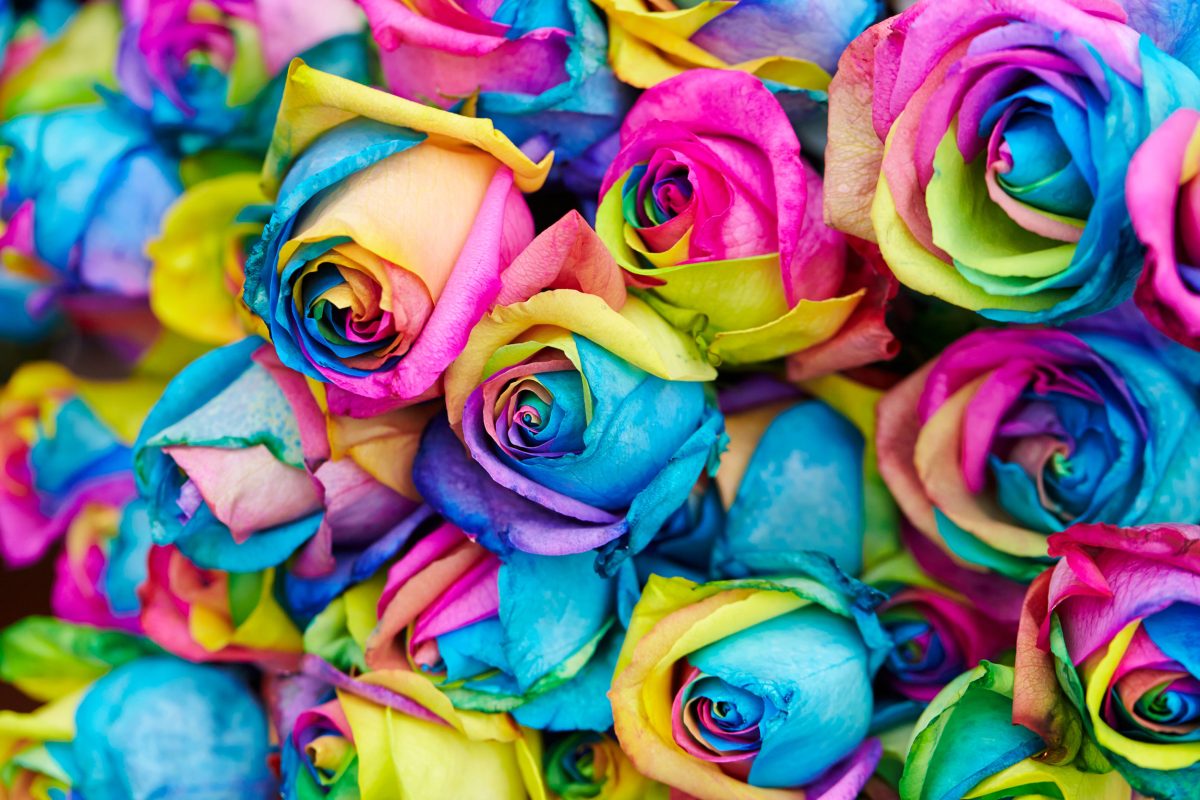
Rainbow is not a rose color. Artificially dyed flowers are not good for the planet or the people who handle them. Photo by mnimage/Shutterstock
Disrupting conventional floristry—with its entrenched ethos of fresh flowers when you want them, where you want them, seasonality and sustainability be damned—is complicated. Feasby knows this. “The only perfect solution would be for me to go out into my backyard and cut myself a bouquet and put it in a vase, but what if you don’t have access to a backyard? What are the better choices you can make?” she says. For Feasby, Prinzing, and other florists looking to make their businesses less harmful to the environment, there’s an easy place to start: ditch floral foam.
Poke around a vessel or vase holding a floral arrangement and you might hit a mushy block of green foam. Highly absorbent and soft enough to support flower stems, floral foam—mostly brick-shaped, but also fashioned into wreaths, hearts, crosses, cones, and more—hit the market in the 1950s and drastically changed an industry that had been getting along just fine without it.
The transformation came when a failed product found a home. Scientists at the American chemical company Union Carbide were experimenting with plastics when they invented a rigid foam that was light, crushable, and useless—to Union Carbide. But chemist Vernon Smithers was intrigued and purchased the rights. After some tinkering, he found that the foam absorbed water, making it perfect for both hydrating and supporting flowers. In 1953, he filed a patent for an “absorbent material for floral arrangements.” Here was this thing that anyone, whether trained as a florist or not, could use to arrange flowers.
“Suddenly, floristry was accessible to the everyday person,” says Rita Feldman, an Australian florist and founder of the Sustainable Floristry Network. The early marketing campaigns targeted home users, she explains—it was like, “You, too, can be a floral artist; simply wet this block of foam, poke your flowers in, and they will stay where you want them to stay.”
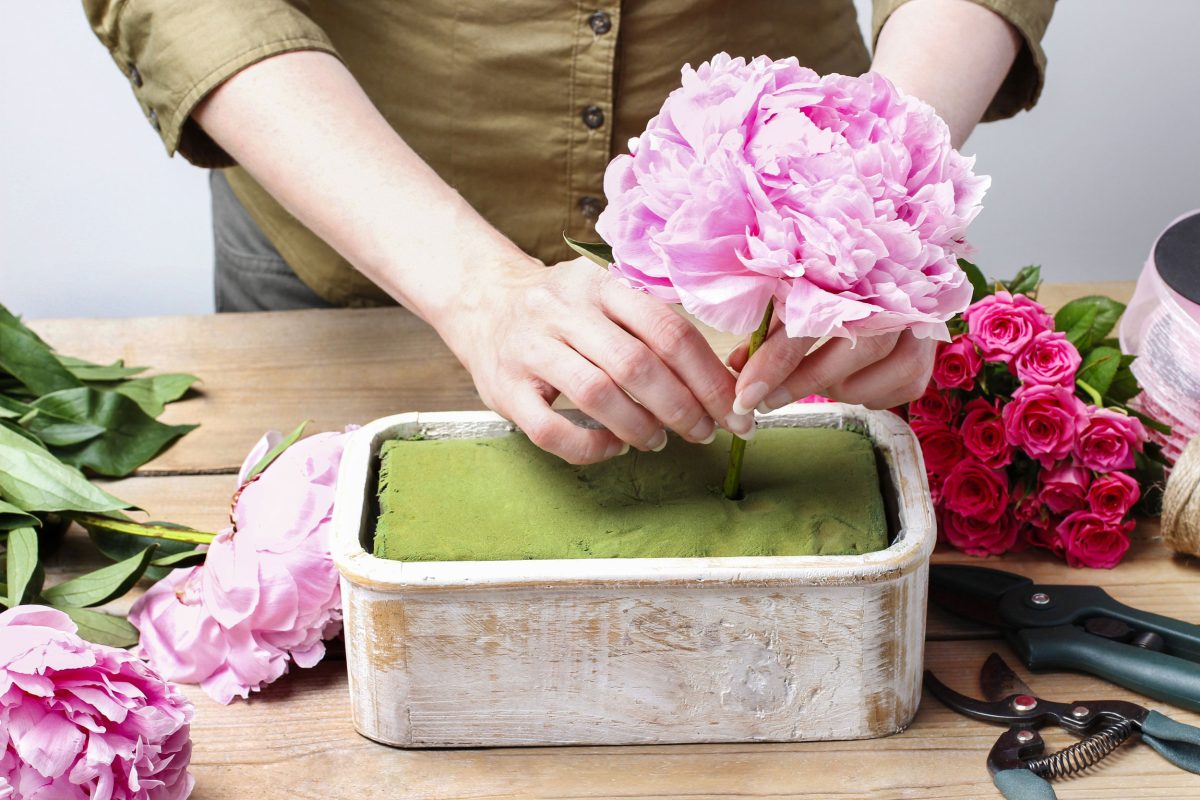
For decades, floral foam made of phenol-formaldehyde resins has been a go-to material in floral design. It is highly absorbent and sturdy enough to hold flowers in place. Floral foam is ubiquitous in the conventional floristry trade, particularly for large installations, funeral wreaths, and wire-service flower orders that require uniformity. Photo by Agnes Kantaruk/Shutterstock
Seventy or so years later, floral foam is a product so ubiquitous in the industry it’s entwined in education (it’s a basic supply in most floral design schools), design competitions, and other sponsorships. It’s as if floral design didn’t exist before floral foam.
Flip through an art history book for such gems as Jan Brueghel’s Still Life of Flowers in a Stoneware Vase (1610) or 14th century ikebana artists of Japan, and it’s evident that the art of flower arranging has deep, and foam-free, roots. Up until the 1950s, florists and anyone who enjoyed flowers in their home were using glass, ceramic, or metal flower “frogs”—small devices with spikes, hooks, or holes that fit into a container—frameworks of twigs or chicken wire, or simply just water in a vase to support their arrangements.
Feldmann was raised in the floristry industry—her mother was a florist and her family had retail shops—and even though floral foam had been available for decades when she was starting in the trade in the 1990s, her family mostly relied on traditional techniques. “I learned floristry without it,” she says, “and my mother did her training without it so [floral foam] was a novelty.” Still, the product crossed her path, and it made her uneasy. “It was this funny, texturally odd thing. You poke your finger in, and it’s all a little bit strange.” She recalls a distinct moment when she was pouring out a bucket of water, watching the water drain. “I remember seeing the particles going swirling into the sink, and I thought, What is it and where is it going?”
When Feldmann launched her own floral business in 2006, floral foam was something she used only rarely and then it was usually just to reuse blocks she found left behind at large venues. “I had this funny line of thinking where I felt that I had to give it a life or make use of it or justify its existence,” she says. The denouement came when she was cleaning up after a wedding and saw about 30 bricks of foam in the green waste bin. Someone clearly thought it was compostable, but was it? What was this stuff and how was it affecting living things?
Feldman made it her mission to find out.
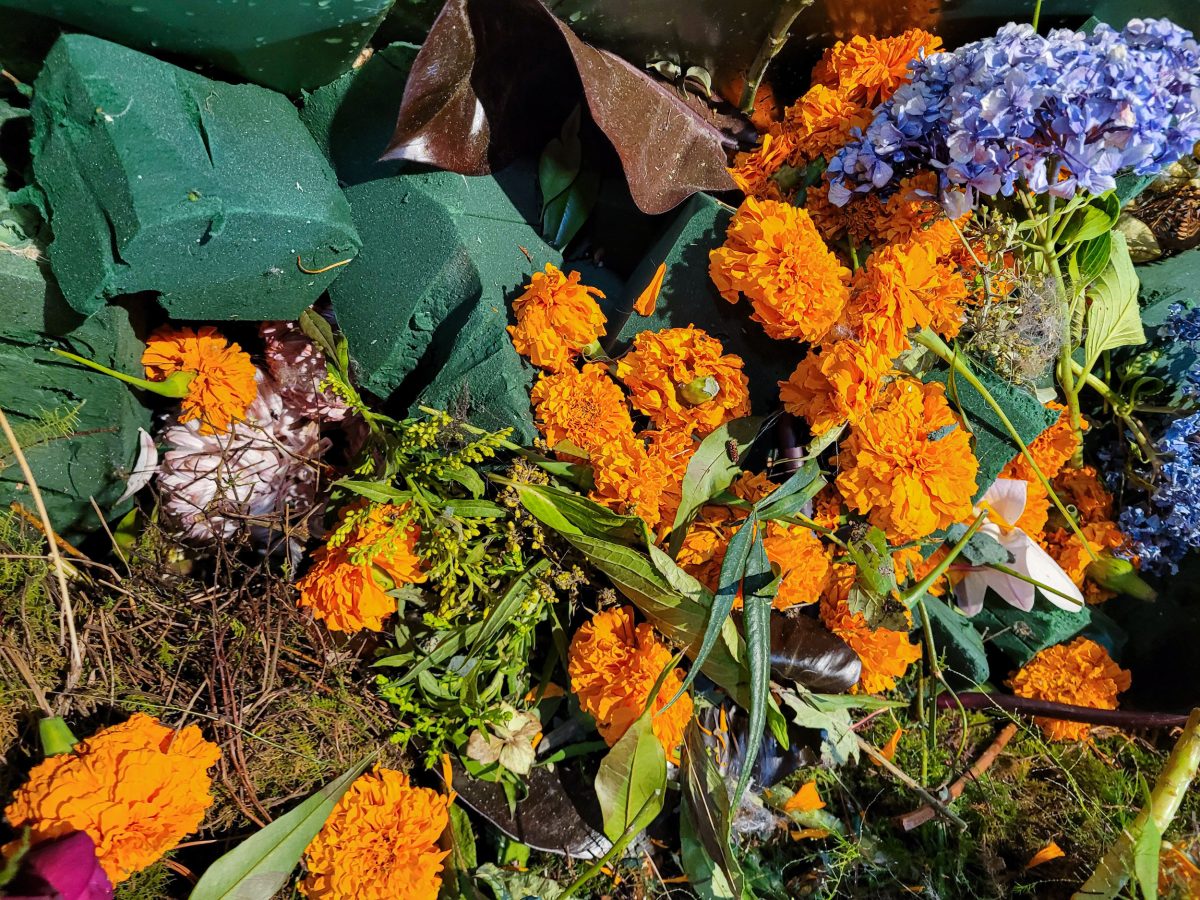
Floral foam is a single-use plastic that is usually discarded in the trash. The foam crushes easily, forming microplastics, which are washed down the drain when vases are emptied. Photo courtesy of Sustainable Floristry Network
She reached out to the manufacturer, Smithers-Oasis, requesting the material safety data sheet with no response. It took several months of searching, but she finally obtained the information from a third party, which revealed the source: a “green fine-celled thermoset phenolic plastic foam.”
Concerned about the fate of floral foam in the environment, she contacted a former botany prof from the University of Melbourne, and the product eventually landed in front of Charlene Trestrail an ecotoxicologist now with the University of Technology Sydney in Australia.
Even as a microplastic researcher, the product had slipped Trestrail’s gaze. “I was like most consumers,” she says. “I had never really paid attention to that spongy green stuff at the bottom of the floral box. I just kind of assumed it was some sort of moss composite.” She was doing her PhD on microplastic pollution in the environment at Melbourne’s RMIT University at the time and became “fascinated by what was potentially an unusual and novel source of microplastic pollution,” she says.
“Novel,” because up until then, most work on the biological responses of plastics had focused on polyethylene and polypropylene microplastics—the plastics used in such things as drink bottles, plastic cutlery, and other single-use plastics. Phenol-formaldehyde resins that comprised the two types of floral foam Trestrail examined had no “biological response information” available despite being a plastic that has been commercially manufactured longer than any other family of synthetic polymers.
A viral social media trend highlighted the problem of floral foam’s unknown threat: ASMR videos showing clip after clip of people crushing foam, often glitter-coated, for fun. To Trestrail, the alarming videos were a clear sign that public education was lacking. “It’s a social phenomenon that has real-world environmental pollution consequences,” she says.
In her study, Trestrail examined six aquatic invertebrates‚ four of which were marine—a mussel, a snail, and two crustaceans—and found that all of them ate the floral foam. At the cellular level, she found signs of stress and damage caused by the ingestion of the plastic itself and also by the plastic leachates in the water. Although the microplastics and the chemicals they contain didn’t cause outright death, their harm is insidious and can lead to reduced growth rates and reproduction, explains Trestrail. “These things start at a cellular level,” she says, “but can build up to real-world consequences for the animal eating the plastic.”
A 2020 research study showed that aquatic and marine invertebrates, including this Daphnia, ate microplastics from floral foam. Video by Charlene Trestrail, RMIT University
Publication of Trestrail’s peer-reviewed paper in 2019 generated media attention and also a rebuttal from Smithers-Oasis, which took exception to her work, noting that the research did not “reflect real-world conditions” nor show outright mortality. Trestrail supported her results in a detailed response, clearly citing sound methodologies, backed up with over a dozen research papers other than her own.
In a way, Trestrail’s work was a convenient target for the company—by attempting to poke holes in her research, it could sidestep the fact that it had created a single-use product that contributes to plastic waste in terrestrial, aquatic, and marine environments. Despite the press release being rich with phrases that purport the company’s commitments to sustainability and the “elimination of waste,” efforts to ameliorate the impacts are tenuous. One safety data sheet suggests disposing of the foam by cutting it up to use as a soil conditioner, and while the company touts some products having “enhanced biodegradability” in a “biologically active landfill,” the chance of the foam actually making its way to such a facility is dubious since most landfills are, by design, not biologically active. (Plus, “biodegradability” is a nice-sounding word with a muddled meaning, making it a darling of greenwashing subterfuge.)
While Trestrail was investigating the specific impacts of floral foam, Feldmann had been on her own path to spread the word of a wasteful and unnecessary product. She started the Instagram account @nofloralfoam in 2017, using the hashtag of the same name. “When I started, there were 36 instances of the hashtag #nofloralfoam, and now there are over 200,000,” she says.
As she continued her search for information on floral foam and other harmful floristry practices, Feldmann realized there was a big gap in education. Many instructors she met were frustrated by the reliance on floral foam and a system that was “very, very outdated.” In Australia, “vase arranging”—flowers in a vase with water—is not taught as a required skill, says Feldman. “That’s how out of touch [floristry education] is.” To fill the gap, she launched the Sustainable Floristry Network in 2019, which in 2023 will launch a new professional development program that aligns with the United Nations sustainable development goals.
Shifting floristry to more sustainable practices is going to take action on various fronts. Florists need to forgo foam, embrace new—or re-embrace old—techniques, and educate their customers. Some are well on their way. Feasby delivers corsages and boutonnieres in recycled plastic clamshells that she reclaims after events; uses hemp twine and organic ribbons of linen, silk, or cotton; offers her services only during the Calgary growing season; and is upfront with customers as to what is possible. Floral foam is out, and so are tulips in October, but every exchange with a customer is a way to present sustainable alternatives.
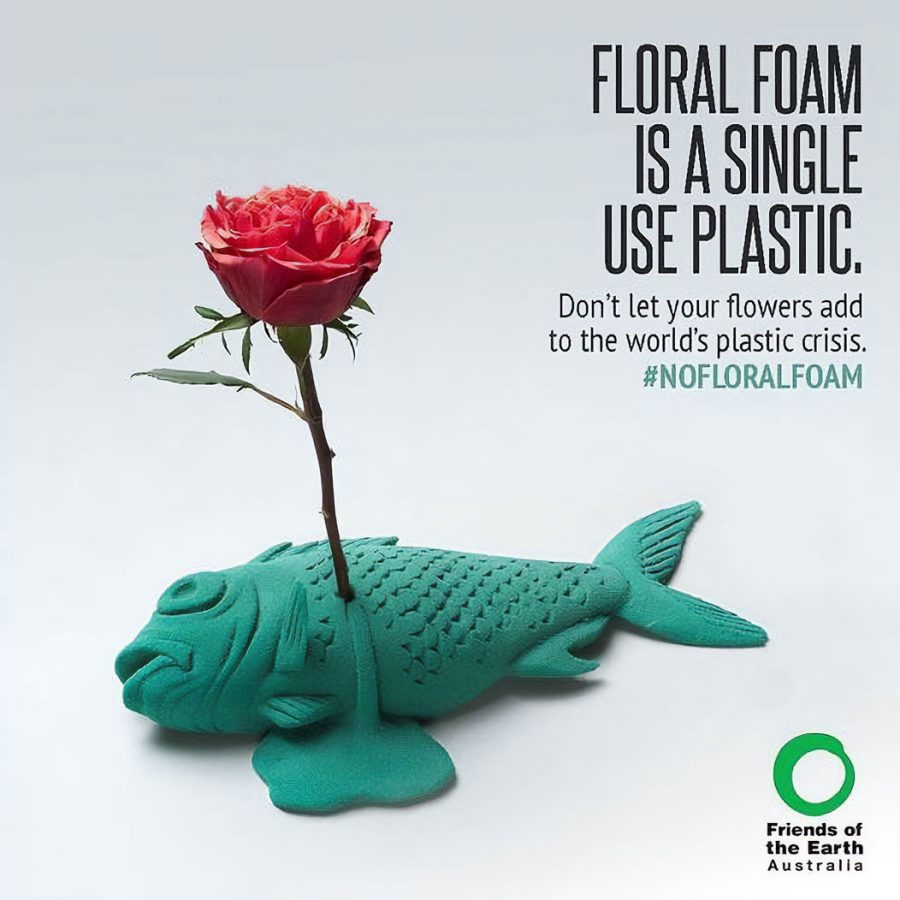
Flower arrangements can be creative and long lasting without floral foam. Photo courtesy of Friends of the Earth Australia
Feasby also convenes the annual Sustainable Flowers Project, which teaches practices rooted in environmental, social, and economic sustainability. This includes teaching large-scale installations, a part of the industry that leans heavily on floral foam.
In her years providing flowers for large weddings and events, Feldmann concedes that using foam might have been easier for clients who wanted things “upside down and back to front and hanging from the rafters.” “Foam,” she says, “allows you to defy gravity.” Those grand installations—and the grand events they’re usually part of—require masses of foam, and moving beyond foam as the default design tool drives innovation and is shaking up an industry that’s stagnating, she says. “People are forced to think, rather than to just produce.” Today, creative florists are using “green mechanics”—wire, wood, concrete, and flower tubes that hold water for each stem, for instance—to create reusable arches, hanging flower “chandeliers,” and other sculptural pieces that in the past relied on bases of floral foam.
Florists eschewing foam and innovating their businesses and designs, and customers making “a conscious choice,” as Prinzing says weekly in her podcast intro, will go a long way to ensure that the flowers we love don’t literally cost the Earth.
Ultimately, though, policy is going to be the lever that causes real change, says Prinzing. And it’s starting to happen at varying levels. In 2020, the Royal Horticultural Society banned the use of floral foam at all of its shows, including the famed Chelsea Flower Show. Also in the United Kingdom, the Sustainable Church Flowers movement, founded by Candy Connolly and her husband, Shane, florist to the Royal family, aims to inspire parishioners to “glorify God sustainably,” by reducing pollution and the carbon footprint of church flowers.
Prinzing also points to the many cities that have banned many single-use plastics, but are still giving single-use foam a pass. She wonders if the European Union’s push to eliminate single-use plastic could eventually be expanded to include floral foam and if that might be just the stick that’s needed, particularly in Holland, the center of global floriculture. “If they are forced to change for EU rules, then I think it will come to [North America.]”
Until change at scale happens, it will happen one person, one bouquet, one blossom at a time—unbleached, undyed, #grownnotflown, #foamfree, simply arranged in water.

